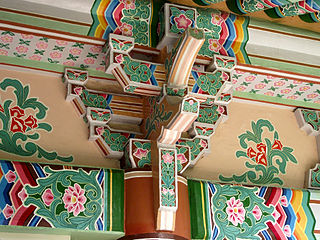
Bulguksa (Korean: 불국사) is a Buddhist temple on Tohamsan,in Jinhyeon-dong,Gyeongju,North Gyeongsang Province,South Korea.

Gyeongju,historically known as Seorabeol,is a coastal city in the far southeastern corner of North Gyeongsang Province,South Korea. It is the second largest city by area in the province after Andong,covering 1,324 km2 (511 sq mi) with a population of 264,091 people as of December 2012. Gyeongju is 370 km (230 mi) southeast of Seoul,and 55 km (34 mi) east of Daegu. The city borders Cheongdo and Yeongcheon to the west,Ulsan to the south and Pohang to the north,while to the east lies the coast of the Sea of Japan. Numerous low mountains—outliers of the Taebaek range—are scattered around the city.

National Treasure (Korean: 국보) is a national-level designation within the heritage preservation system of South Korea for tangible objects of significant artistic,cultural and historical value. Examples of objects include art,artifacts,sites,or buildings. It is administered by the Cultural Heritage Administration (CHA). Additions to the list are decided by the Cultural Heritage Committee.

Korean architecture refers to an architectural style that developed over centuries in Korea. Throughout the history of Korea,various kingdoms and royal dynasties have developed a unique style of architecture with influences from Buddhism and Korean Confucianism.

The Gyeongju National Museum is a museum in Gyeongju,North Gyeongsang Province,South Korea. Its holdings are largely devoted to relics of the Silla kingdom,of which Gyeongju was the capital.

Hwangnyongsa (Korean: 황룡사),alternatively Hwangnyong Temple or Hwangryongsa,was a Buddhist temple in the city of Gyeongju,South Korea.

Namsan is a 494-meter peak in the heart of Gyeongju National Park,just south of Gyeongju,South Korea. The mountain is within easy reach from the city and attracts a large number of domestic tourists. Namsan covers an area of about 8 km (north-south) by 12 km (east-west). Some 180 peaks are counted,of which Geumobong and Gouibong are the best-known. There are about 40 valleys.
Tourism in Gyeongju is a major industry and defining feature of Gyeongju,South Korea. Gyeongju is a major cultural site and tourist destination for South Koreans and foreigners with about 8 to 9 million visitors annually. A great deal of this is due to the city's status as a center of Silla heritage,derived from its former role as the capital of that ancient kingdom.

Golgulsa is located 20 km east of the ancient Silla Dynasty capital city of Gyeongju in Southeastern Korea. In the Golgulsa temple area can be found the oldest historical Buddhist ruins on Mt. Hamwol and the only cave temple in Korea.

Woljeongsa (Korean: 월정사) is a head temple of the Jogye Order of Korean Buddhism,located on the eastern slopes of Odaesan in Pyeongchang County,Gangwon Province,South Korea. Woljeongsa was founded in 643 by the Silla monk Jajang.

Geumsansa is a temple of the Jogye Order of Korean Buddhism standing on the slopes of Moaksan in Gimje City,Jeollabuk-do,South Korea.

Dabotap (Korean: 다보탑) is a stone pagoda located in the Buddhist temple of Bulguksa in Gyeongju,South Korea. From entering the temple through the Cheongun and Baegun Bridge,Dabotap is located on the right side,opposing Seokgatap on the left side. The pagoda is supposed to have been built in 751,the 10th year of the Shilla king Gyeongdeok. It is currently designated as National Treasure no. 20.
Gamsansa refers to a Korean Buddhist temple established during the country's Unified Silla dynasty. Save for a partially reconstructed pagoda,none of the original temple structures survive. Gamsansa was located approximately 20 kilometers south of the city of Gyeongju,at the time the capital of Silla,not far from the more famous Silla temple of Bulguksa.

Wolseong Palace Site,Gyeongju,also commonly known as Wolseong Palace,was the royal palace compound of the Korean Silla monarchy at their capital in Gyeongju during the Silla and Unified Silla periods. It takes its name from the approximate outline of the palace walls which were shaped like a crescent moon. Banwolseong has been also known as Sinwolseong or Jaeseong,which means where the king resides.

Bunhwangsa is a temple complex from the Old Silla era of Korea. It is located in Gyeongju. The temple is recorded to have been built in 634 under the auspices of Queen Seondeok. Today the temple is still used by a small group of worshipers but in its heyday,the temple covered several acres and was one of the four main temples of the Silla Kingdom used by the state to ask the Buddha to bless the kingdom. The ruins of Hwangnyongsa Temple lay nearby. It is part of the UNESCO world heritage site Gyeongju Historic Areas.

The Borisa Sitting Buddha is located at the east slope of Namsan Mountain in Gyeongju,South Korea. This site is supposed to be the place where Borisa temple had stood during the Silla period. The stone sculpture is 4.36m high,and the seated Buddha image itself is as high as 2.44m. Among the existing Buddhist images on Mt. Namsan,this image is best preserved. The Buddha sitting on the octagonal lotus pedestal is the image of Sakyamuni,who smiles at the world with the half-closed eyes and a merciful facial expression. Small Buddhist images and floral medallion designs are carved on the halo. On the back of the pear-shaped halo,the Bhaisajyaguru Buddhaup-holding a medicine bowl in his left hand is carved in relief.

The Baekje Historic Areas are a group of monuments located in three South Korean cities:Gongju,Buyeo,and Iksan. They relate to the last period of the Baekje Kingdom,representing the period from 475 to 660 CE,which was one of the three kingdoms that flourished from 18 BC to 660 CE. The property designated as a UNESCO World Heritage Site has eight archaeological sites. These are:The Gongsanseong fortress and the royal tombs at Songsan-ri,related to the capital city of Ungjin,now Gongju;the Busosanseong Fortress and Gwanbuk-ri administrative buildings,the Jeongnimsa Temple,the Neungsan-ri royal tombs,and the Naseong city wall in Sabi,now Buyeo;and the Wanggung-ri Palace and the Mireuksa Temple in Iksan,a subsidiary capital region of Sabi.

Korean pagodas are a traditional Korean architectural form that began in the Three Kingdoms of Korea period. Koreans created a unique and distinct pagoda tradition using stone.



















